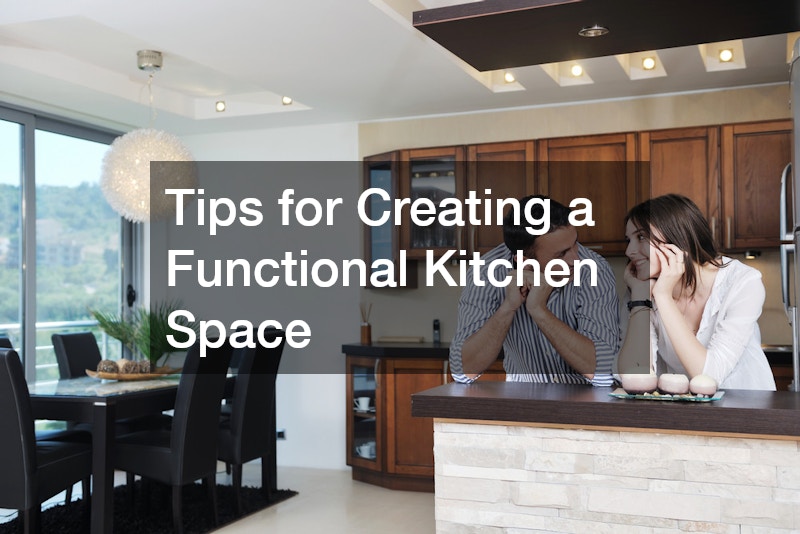Creating a custom home kitchen is an opportunity to build the heart of your home exactly the way you envision it. More than just a space for preparing meals, the kitchen serves as a central hub for family gatherings, everyday routines, and creative expression. A successful design combines functionality with personal style and ensures long-term usability. In this guide, we’ll walk through the essential features, materials, and upgrades to include when building a custom kitchen that’s both beautiful and built to last.
How to Design the Layout of a Custom Home Kitchen

Understanding the Work Triangle
The work triangle—a configuration connecting the stove, sink, and refrigerator—is a timeless layout principle that promotes efficient movement in the kitchen. A compact and uninterrupted triangle minimizes unnecessary steps, helping you cook, clean, and prep more fluidly. During the design phase, your general contractor will ensure the dimensions of the triangle remain optimal while also accounting for the placement of cabinets, doors, and other built-in features.
Maximizing Counter Space
Expansive counter space is a necessity in a well-functioning kitchen. Whether you’re prepping meals, using small appliances, or setting up for entertaining, you need enough room to work comfortably. Collaborate with experienced countertop contractors to incorporate a variety of surfaces while considering both function and form. Options like quartz countertops offer an elegant, durable, and low-maintenance surface ideal for busy households. Maximizing workspace along perimeter walls and including overhangs on islands will provide the surface area you need.
Integrating Kitchen Islands
Islands bring flexibility and multi-functionality to any kitchen layout. They can serve as food prep stations, seating areas, or storage hubs. In larger kitchens, you might even integrate a sink, dishwasher, or cooktop directly into the island. It’s important to ensure the island doesn’t interrupt the kitchen’s flow—your general contractor will help determine the ideal dimensions and clearances for your space.
Choosing the Right Appliances
Appliance selection should match your cooking style and daily needs. From double ovens to built-in microwaves, today’s market offers high-efficiency and smart-enabled appliances that boost convenience. Consult with your electrician early in the process to plan for necessary circuits and outlets, especially for ranges, refrigerators, and under-cabinet lighting. Don’t forget to involve your plumber for water lines to fridges and dishwashers, and your HVAC technician for ventilation requirements associated with range hoods and oven heat dispersion.
Planning for Storage Solutions
Storage is a fundamental aspect of kitchen design. Custom kitchen cabinet layouts allow you to optimize space with specialized drawers, pull-out shelves, corner units, and vertical dividers. Think about everything you use daily and work with your general contractor to build cabinetry that keeps it organized and accessible. A walk-in pantry or floor-to-ceiling cabinetry may be essential if you buy in bulk or need space for small appliances.
What Materials to Use in Custom Home Kitchens
Benefits of Granite Countertops
Granite countertops remain a favored option for homeowners seeking a natural, durable, and visually striking material. Resistant to heat and scratches, granite is a strong choice for areas that see heavy use. Many countertop contractors still recommend granite for its timeless appeal and broad range of color and veining options.
Advantages of Hardwood Flooring
Hardwood adds a classic and warm finish to the kitchen, tying the room together with natural grain and rich tones. It’s both stylish and comfortable underfoot. When working with a flooring service, ask about prefinished and engineered wood options for better moisture resistance. For those preferring stone or tile, consider heated flooring solutions to maintain comfort in colder climates.
Selecting Cabinet Materials
The foundation of your storage, kitchen cabinets define much of the room’s look. Wood remains the most popular material for its longevity and customizable finishes. However, modern kitchen cabinet designs also include composite options like MDF with laminate or thermofoil coverings for a sleek aesthetic. Soft-close hinges, under-cabinet lighting, and custom inserts for organization all add value.
Options for Backsplash Design
A backsplash adds visual flair while protecting the walls from moisture and stains. Popular materials include ceramic and porcelain floor tiles, glass mosaic, stainless steel, and natural stone. If you’re aiming for texture, consider using the same material from your countertops for a seamless, high-end effect. Your general contractor or tile installer can help with layout and installation.
Considerations for Kitchen Sinks
Kitchen sinks need to accommodate both the aesthetic and functional demands of the space. Options range from farmhouse sinks to undermount stainless steel models. Make sure your plumber installs all fixtures securely and checks that drainage lines are appropriately sized. Composite granite sinks and double-bowl designs are gaining popularity for their durability and functionality.
How to Optimize Lighting in a Custom Kitchen
Importance of Task Lighting
Bright, focused lighting over key work areas such as countertops and cooktops is essential for safe and efficient food prep. Work with your electrician to ensure your electrical service plan includes designated circuits for under-cabinet lights, ceiling fixtures, and pendant lighting. LED strip lighting beneath upper cabinets is a popular and energy-efficient option.
Utilizing Natural Light
Natural light is an often underappreciated design asset. Including large windows, French doors, or even a skylight can make the space feel more open and inviting. If the kitchen is interior-facing, solar tubes can channel daylight in without compromising structural integrity.
Choosing Pendant Lighting
Pendant lights are ideal for islands and dining areas. They add both illumination and style to the space. Whether you opt for industrial metal shades or glass globes, your electrical service provider should coordinate the layout to ensure even lighting and visual balance across the room.
Under-Cabinet Light Solutions
Under-cabinet lighting enhances visibility and adds ambiance. Popular choices include LED puck lights and strip lights, which can be hardwired by your electrician for a cleaner finish. Make sure the electrical service plan includes switches or dimmers for adjustable brightness.
Accent Lighting Options
Accent lighting brings drama and sophistication to a kitchen. Toe-kick lights at the base of cabinetry, interior lights inside glass-front cabinets, or ceiling-mounted ambient lights can enhance the atmosphere. Smart lighting systems allow full control from your smartphone or voice assistant.
Tips for Creating a Functional Kitchen Space

Importance of Accessibility
Designing with accessibility in mind benefits everyone. Pull-down shelves, shallow-depth countertops, and lever-handle faucets all improve ease of use. These elements can be integrated during construction to ensure your kitchen remains functional regardless of age or mobility level.
Efficient Use of Space
Efficient kitchens make use of every inch, especially in tight layouts. Toe-kick drawers, vertical dividers, and pull-out trash bins are examples of maximizing small areas. Your general contractor can help identify dead zones and convert them into usable storage.
Streamlined Workflow Tips
Grouping kitchen zones by function—cooking, cleaning, prep, and storage—improves the natural flow. Keep dishware near the dishwasher, utensils near the prep space, and trash bins close to the sink. When laid out logically, these zones help save time and reduce clutter.
Multi-Functional Design Elements
Today’s kitchens are used for more than just cooking. Consider including a breakfast bar, a homework zone for kids, or a beverage station with a built-in wine fridge. Multi-functional designs increase your kitchen’s value and adaptability.
Incorporating a Command Center
A kitchen command center can help manage the household. This space might include a bulletin board, charging stations, mail organizers, and a small calendar area. Custom kitchen cabinet designs often carve out a drawer or shelf to manage paperwork and electronics discreetly.
What Colors Work Best in Custom Kitchens
Trending Kitchen Colors
Bold cabinet colors like navy, forest green, and charcoal are trending, often paired with neutral walls and countertops. Warm metallics such as brass or bronze offer contrast and sophistication when used in hardware or lighting.
Impact of Color on Space Perception
Lighter shades can visually expand a small kitchen, while darker tones can make a large space feel cozier. Use reflective surfaces and glossy finishes to bounce light and make the room feel more open.
Coordinating with the Rest of Your Home
A consistent color palette between the kitchen and adjacent rooms enhances visual flow, especially in open-concept homes. Coordinate flooring and cabinetry tones for a seamless look. A professional flooring service can help match new floor tiles to your existing finishes.
Tips for Using Bold Colors
Use bold colors selectively on islands, backsplashes, or accent walls so they enhance rather than overwhelm. Keeping primary cabinets or countertops in neutral tones ensures the kitchen doesn’t feel too busy.
Neutral Palette Ideas
Timeless palettes using whites, grays, taupe, and soft earth tones remain popular for their versatility. They pair well with any style, from modern farmhouse to minimalist. Neutral tones also provide the perfect backdrop for statement fixtures or artwork.
What Smart Technology Can Be Included in Custom Kitchens

Smart Appliance Options
Smart appliances like refrigerators, ovens, and dishwashers can be controlled remotely, provide usage updates, and integrate with home automation systems. These options add convenience, reduce energy use, and can even help with meal planning.
Smart Lighting Systems
Smart switches, dimmers, and programmable scenes allow complete control of kitchen lighting. Your electrician can incorporate these technologies during the rough-in phase to ensure compatibility with your home’s broader electrical service.
Integrated Sound Systems
Bluetooth speakers and integrated sound systems let you listen to music, podcasts, or news while cooking. These systems can be built into the walls or ceilings for a clean, uncluttered appearance.
Touchless Faucets
Motion-activated faucets are both sanitary and practical. They help reduce the spread of germs and are especially useful when your hands are full or messy. A licensed plumber can install these fixtures safely and ensure consistent water pressure.
Smart Storage Solutions
Cabinet lifts, motorized drawers, and app-connected inventory systems are cutting-edge features for luxury custom kitchens. These innovations help you keep track of items and maximize space with minimal effort.
How to Incorporate Eco-Friendly Options in Custom Kitchens
Sustainable Material Choices
Eco-friendly materials like bamboo, recycled glass, and reclaimed wood offer durability with a lower environmental footprint. Work with your general contractor to source products that are both stylish and responsible.
Energy-Efficient Appliances
ENERGY STAR-rated dishwashers, refrigerators, and ovens use less power and reduce utility costs over time. Your HVAC contractor can also install energy-efficient ventilation and air circulation systems to maintain comfort without waste.
Water-Saving Fixtures
Low-flow faucets and aerators help conserve water without sacrificing performance. Choose fixtures approved by your plumber that are designed to reduce usage while maintaining strong flow.
Recycling and Composting Stations
Built-in bins for compost, recycling, and waste make it easy to live sustainably. Your kitchen cabinet layout should include a designated pull-out drawer or under-sink area for these containers.
Solar-Powered Kitchen Options
If your home includes solar panels, the kitchen is a great place to leverage that power. Charging stations, lighting, and even some appliances can be connected to solar arrays, reducing your carbon footprint and monthly bills.
How to Inspire Creativity in the Kitchen Design Process
Personalizing Your Space
From custom hardware to display shelves for cookbooks or art, personalization adds warmth and character. Think about how you want the space to feel—welcoming, modern, rustic—and design accordingly.
Incorporating Unique Design Elements
Statement floor tiles, arched doorways, or open beams can add architectural interest. Work closely with your general contractor to make sure these elements are not only visually impactful but structurally sound.
Inspiration from Design Magazines
Home design magazines and websites offer a wealth of ideas. Collect samples, clips, and photos to guide your choices and clarify your style before beginning construction.
Working with a Kitchen Designer
An experienced kitchen designer can streamline decision-making, ensure functionality, and work hand-in-hand with your general contractor, electrician, plumber, and flooring service team to execute your vision flawlessly.
Moodboarding Techniques
Use tools like Canva or Pinterest to compile visuals of your dream kitchen. Sharing this with your design-build team ensures everyone’s aligned before installation begins.
How to Budget for a Custom Home Kitchen
Prioritizing Essential Elements
List out must-haves like a kitchen island, upgraded appliances, or specific materials. Build your budget around those before allocating funds to optional add-ons.
Estimating Costs for Materials
Get detailed quotes for items like quartz countertops, cabinetry, and floor tiles. Ask your countertop contractors and flooring service for price ranges across material grades to compare your options.
Calculating Labor Expenses
Labor from your general contractor, plumber, electrician, HVAC technician, and flooring service can make up a substantial portion of your budget. Ensure these professionals are coordinated to avoid scheduling issues and added costs.
Identifying Areas to Save
Refacing existing kitchen cabinets, using mid-tier materials, or choosing standard appliance sizes can help reduce expenses while maintaining quality.
Financing Your Kitchen Renovation
Explore home equity lines, construction loans, or kitchen-specific financing programs to cover the renovation cost. Your general contractor may have partnerships or recommendations to help.
What Safety Features to Consider for Custom Kitchens

Importance of Ventilation
Proper kitchen ventilation ensures smoke, steam, and odors don’t linger. Range hoods connected to your HVAC system and exhaust fans help maintain healthy indoor air quality.
Fire Prevention Measures
Install smoke detectors, fire extinguishers, and flame-retardant materials around stoves. An electrician can also set up automatic shutoffs for high-risk appliances.
Child-Safe Design Ideas
Rounded countertop edges, safety latches on cabinets, and out-of-reach microwave placement can keep kids safe. Discuss these options during the design phase for seamless inclusion.
Anti-Slip Flooring Options
Choose floor tiles or textured hardwoods that minimize slip risk. Your flooring service can help you identify materials that are both attractive and safe.
Secure Storage for Hazardous Materials
Designate locked or high cabinets for knives, chemicals, and medications. Custom kitchen cabinet plans should account for secure, childproofed zones.
Final Thoughts
A custom home kitchen is more than a renovation—it’s a personal investment in how you live. With the right layout, materials, technology, and professional team—including your general contractor, electrician, plumber, flooring service, HVAC technician, and countertop contractors—you can create a space that’s not just functional but truly exceptional.

